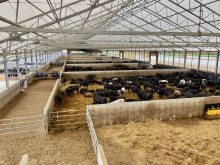An overabundance of beef processing capacity has never been an asset of Ontario farmers. It might be time for them to take that problem into their own hands.
The loss of the Ryding-Regency processor in Toronto in the late fall was another blow. Ryding-Regency was only about 15 per cent of the provincial beef processing market, but taking 15 per cent out of any efficiently functioning market is significant.
It’s meant 10s of thousands of dollars in losses for individual beef farmers as they’ve had to hold cattle until heavier or had to sell them at lower prices or to far-away markets like Western Canada, losing in transportation costs.
Read Also

New Iridium technology helps block GPS spoofing
A tiny new chip will allow Iridium’s Positioning, Navigation and Timing (PNT) signals to be received much smaller devices, create a backstop against Global Positioning Systems (GPS) spoofing.
The market was already tight before Ryding-Regency was shut down over E. coli contamination by the Canadian Food Inspection Agency.
Many beef farmers in Ontario are at a loss about what to do. Is there room for the number of cattle now produced in the province? Is there any room for growth? Is there a real future for a serious beef sector? Ontario was already stuck with a lower feedlot price that has been stubbornly low compared to Western Canada.
The answers are in the hands of farmers and processors.
Being a processor of a global commodity is a tricky game.
Price your purchases too high and you’re out of the global game. Price it too low and your suppliers go out of business. It’s good to have some competition in the market to help keep enough suppliers in business, but you don’t want too much competition or the price can get too high.
The Ontario situation is currently too far tilted to the advantage of the processors, discouraging production, stifling momentum and discouraging innovation.
Who will fix it?
There are good examples in Ontario and elsewhere of livestock producers who have created their own processing facilities — usually in the form of a co-operative of some sort.
The one looked at with most affection here is the highly successful Conestoga Meat Packers — owned by farmers who were once part of the Progressive Pork Producers co-op (known as the 3Ps).
However, anyone involved in 3Ps will tell you that it was long process with several starts and stops along the way. It’s entirely worth it now with the extra value that Conestoga Meat Packers brings to its members, but it was a long road.
Beef producers in Western Canada have tried numerous times to create their own processing capacity, and almost all have failed.
Meat processing on a significant scale requires large capital, human resources and focused marketing capability.
Is it the solution for Ontario? I expect it is not, other than on a smaller scale.
The industry is tightly connected to Cargill, the largest beef processor by far in Ontario. Many farmers feed cattle on contract destined for the Cargill plant.
Any of the valuable branded programs created in Ontario, such as the Ontario Corn Fed Beef program rely on the Cargill plant to process enough animals so that the programs can get the volume they need to be a player in the markets they’ve developed.
Ontario Corn Fed Beef (which has developed significant domestic and increasing Asian markets) is owned by the Ontario Cattle Feeders’ Association and the people around them would be the best set as far as capital and supply of cattle to build a new processing facility.
However, would it make sense for them to spite Cargill by becoming a competitor when Cargill is the major processing partner for their brand? Probably not. Cargill has stepped up its processing volume since Ryding-Regency lost its licence.
What are the alternatives? The Canadian Cattlemen’s Association says Ontario’s processors are interested in expanding. They need to be encouraged. Find the barriers and surmount them. That could fall to government or farmers.
Ontario has access to a large domestic market, increasingly targeted by others around the world, and is close to the major U.S. markets. That’s long been our advantage. Someone needs to step up and make it a greater advantage for Ontario beef producers.
The private sector is the best route in the beef sector and those currently involved are best suited to make it happen.















